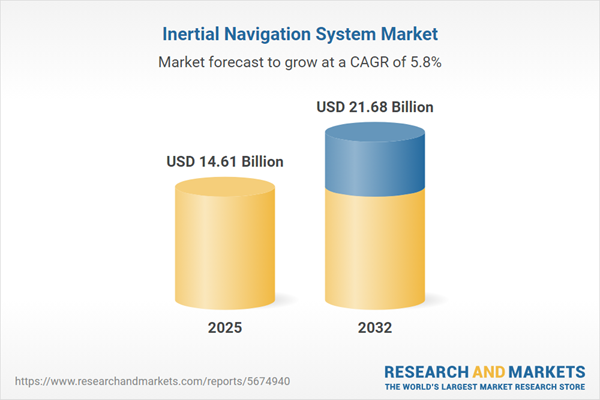Speak directly to the analyst to clarify any post sales queries you may have.
Senior decision-makers are facing rapid change as regulatory shifts and accelerated digitization reshape expectations for critical navigation capabilities. The inertial navigation system market is at the forefront, providing essential technologies for sectors that demand precision, operational resilience, and adaptability.
Market Snapshot: Inertial Navigation System Market Size and Growth Drivers
The inertial navigation system market is registering steady growth, driven by ongoing advancements and heightened investment in next-generation solutions. Strong compound annual growth demonstrates persistent sector demand, with modernization in defense serving as a primary catalyst. As organizations target more accurate and reliable navigation, the commercial aviation industry creates new pathways for technology adoption. Industrial players are investing in advanced positioning to improve robotics and supply chain operations. Improved sensor technology and analytics continue to accelerate market adaptation, ensuring organizations opt for robust, compliant, and future-ready solutions.
Scope & Segmentation of the Inertial Navigation System Market
- Technology: Fiber optic gyroscopes ensure reliable, stable performance in defense and commercial contexts. Hemispherical resonator gyroscopes support specific military applications. MEMS and nanoscale variants deliver lightweight solutions suited for autonomous or mobile units. Ring laser gyroscopes are essential within aerospace, offering high precision for demanding projects.
- Application Areas: Navigation systems enhance operational efficiency across military and commercial aviation, optimize vehicle routing in automotive fields, and improve outcomes in automation, robotics, mining, industrial handling, and maritime operations.
- Installation Types: Integrated solutions combine GNSS, odometric, and inertial data, supporting high-reliability needs in complex contexts. Standalone systems meet requirements where integration is not aligned with operational priorities.
- Core Components: Accelerometers and gyroscopes form the fundamental hardware, while Inertial Measurement Units (IMUs) enable flexible and redundant operation in varying environments.
- Geographical Reach: Uptake is robust across the Americas, Europe, Middle East and Africa, and Asia-Pacific. Asian countries such as China, India, Japan, Australia, South Korea, and those in Southeast Asia drive technology advances and regional supply chain strategies.
- Key Market Participants: Honeywell International Inc., Northrop Grumman Corporation, Raytheon Technologies Corporation, Safran S.A., Thales S.A., BAE Systems plc, L3Harris Technologies Inc., Collins Aerospace Inc., Kongsberg Defence & Aerospace AS, and Moog Inc. play significant roles in shaping product and market direction.
Key Takeaways for Strategic Decision-Makers
- Sensor innovation bolsters navigation system dependability, helping maintain critical business function in variable and high-demand environments.
- Advanced sensor fusion and artificial intelligence simplify device calibration, supporting more accurate navigation for operations prioritizing adaptability.
- Modular architectures enable straightforward technology upgrades, reducing barriers as organizational requirements evolve.
- Focusing on regional assembly and strengthening supplier diversity helps organizations mitigate procurement risks caused by market shifts and new regulations.
- Strategic collaboration between manufacturers and solution integrators supports tailored platforms that can be scaled to meet complex operational needs across sectors.
Tariff Impact: Navigating Cost and Sourcing Pressures
Recent U.S. tariffs on components such as semiconductors, rare earth materials, and fiber optic parts are impacting inertial navigation system sourcing and overall cost structures. Companies are adjusting procurement tactics, including new supplier alliances in Asia-Pacific and European markets. By prioritizing regionalized assembly and refined customs processes, organizations strengthen sourcing agility, keep material costs stable, and enhance operational continuity amid shifting trade dynamics.
Methodology & Data Sources
This assessment uses proprietary datasets, patent reviews, and interviews with key manufacturers, integrators, and end-users. Cross-checking customs data, sector benchmarks, and expert roundtable insights provides reliable, evidence-based procurement guidance for market participants.
Why This Report Matters
- Enables executive teams to develop resilient supply chains and evaluate advanced navigation technologies within an evolving compliance context.
- Explains how segmentation and regional trends shape strategic alignment and highlight paths for cross-industry market entry.
- Connects ongoing technology advancement to actionable business strategies for organizations undergoing operational transformation.
Conclusion
By integrating advanced inertial navigation systems and optimizing regional sourcing, organizations can establish flexible operational frameworks and protect their market standing during ongoing industry evolution.
Additional Product Information:
- Purchase of this report includes 1 year online access with quarterly updates.
- This report can be updated on request. Please contact our Customer Experience team using the Ask a Question widget on our website.
Table of Contents
3. Executive Summary
4. Market Overview
7. Cumulative Impact of Artificial Intelligence 2025
Companies Mentioned
The companies profiled in this Inertial Navigation System market report include:- Honeywell International Inc.
- Northrop Grumman Corporation
- Raytheon Technologies Corporation
- Safran S.A.
- Thales S.A.
- BAE Systems plc
- L3Harris Technologies, Inc.
- Collins Aerospace Inc.
- Kongsberg Defence & Aerospace AS
- Moog Inc.
Table Information
| Report Attribute | Details |
|---|---|
| No. of Pages | 189 |
| Published | October 2025 |
| Forecast Period | 2025 - 2032 |
| Estimated Market Value ( USD | $ 14.61 Billion |
| Forecasted Market Value ( USD | $ 21.68 Billion |
| Compound Annual Growth Rate | 5.8% |
| Regions Covered | Global |
| No. of Companies Mentioned | 11 |









